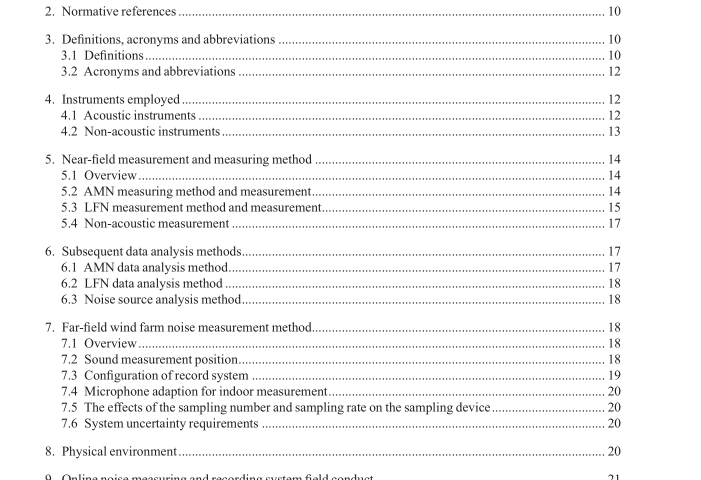IEEE 2400-2016 pdf download.IEEE Standard for Wind Turbine Aero Acoustic Noise Measurement Techniques
This standard provides techniques to select wind turbine and wind farm aero acoustic noise measurements, including instrumentation standards and metrology technology, measurement set, measurement procedures, data processing, and noise source data analysis. The scope of measurement covers near-feld sound measure- ment similar to IEC 61400-11 1 and distance and far-feld sound measurement both outside and inside con- cerned houses or buildings. This standard focuses on amplitude modulation noise, however, guidelines for low-frequency noise including infrasound near-feld measurement are provided. IEC 61400-11 provides over- all wind turbine noise measurement standards, while this standard focuses more on the aero acoustic noise of wind turbines to avoid overlap with IEC 61400-11. Users of this standard should also be familiar with of ANSI S1.1–1994 (R2004), Acoustical Terminology.
1.2 Purpose
This standard establishes standard measurement techniques and methods of analysis to quantify wind tur- bine and wind farm aero acoustic noise. It can be used to understand wind turbine aero acoustic noise, so- called low-frequency/infrasound and amplitude modulation noise, and potential impacts on surrounding communities.
2. Normative references
The following referenced documents are indispensable for the application of this document (i.e., they must be understood and used, so each referenced document is cited in text and its relationship to this document is explained). For dated references, only the edition cited applies. For undated references, the latest edition of the referenced document (including any amendments or corrigenda) applies.
ANSI 12.9, Test Switches and Plugs for Transformer-Related Meters. 2
ANSI 12.18, Protocol Specifcation for ANSI Type 2 Optical Port.
ANSI S1.1-1994 (R2004), Acoustical Terminology.
ANSI S1.42-2001 (R2016), Designed Response of Weighting Networks for Acoustical Measurements.
IEC 60942:2003, Electroacoustics—Sound calibrators. 4
IEC 61400-11, Wind turbines—Part 11: Acoustic noise measurement techniques.
3. Defnitions, acronyms and abbreviations
3.1 Defnitions
For the purposes of this document, the following terms and defnitions apply. The IEEE Standards Dictionary Online and ANSI S1.1–1994 (R2004), Acoustical Terminology, should be consulted for terms not defned in this clause.
background noise: Any noises that are not related to wind turbine and wind farm operation, such as road noise, insect sounds, wind over the microphone, wind over brush and building structures, etc.
far-feld measurement: Noise measurement to be carried out at far feld of a wind turbine in a wind farm in a concerned area such as nearby a residential house.
The microphone is installed at 1.2 m above ground with effective wind screen, usually on a portable tripod. near-feld measurement: Noise measurement to be carried out at distance of the wind turbine hub height plus the radius of the rotor away from wind turbine foundation (the same distance specifed in IEC 61400-11). The microphone is installed on the ground with a ground board and wind screen.
noise-weighting network: Noise measuring equipment has a special sound level meter flter. Sound lev- el measuring through a weighted network is considered as a weighted sound pressure level or sound level.
nline measuring system: Measures and records the continuous or timed data of working equipment condi- tions that are available through the network.
sampling rate: The number of samples per unit time extracted from a continuous signal to make a discrete signal. The sampling rate is set to at least 125 ms (8 Hz) for AMN measurement with a sound pressure level of L A ; 20 ms (50 Hz) for LFN measurement with sound pressure level L G, and 44.1 kHz for the microphone raw signal sound recording.
sound metrics (L eq , L 90 , L 5 ): Acoustic measurements taken over an extended period of time generally fuctu- ate randomly and/or periodically. The range, trend, and energy content of the fuctuating levels are typically represented by the statistical levels L 90 , L eq, and L 5 . L 90 is the sound level that is exceeded 90% of the time during the interval. L 5 is the sound level that is exceeded 5% of the time during the interval. The energy-aver- age level of the sound over the measurement time interval is L eqT , where T is the length of the interval. wind turbine aero-acoustic noise: Caused by air fowing around rotating blades, the interaction between ro- tating blades and unsteady fow forms a boundary layer and generates trailing-edge noise. It is also caused by aerodynamic pressure changes around rotating blades in the presence of tower, wind shear, and atmospheric turbulence. This can be caused by many other kinds of complicated phenomena, such as fow separation from boundary layer—the process of which causes air turbulence that brings noise. In general, aerodynamic sound increases when the blade rotating speed goes up. From an acoustic view point, wind turbine aero acoustic noise is presented by amplitude-modulation noise (AMN) and low-frequency noise (LFN), including infrasound.IEEE 2400 pdf download.IEEE 2400-2016 pdf download
IEEE 2400-2016 pdf download

Leave a Reply